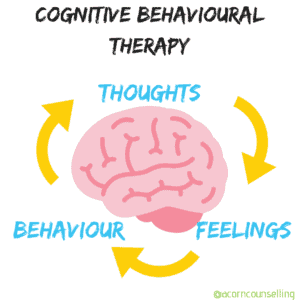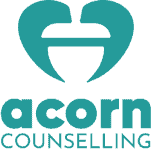Cognitive Behavioural Therapy, or CBT, is an evidence based treatment modality. This means that it has been proven to be effective for many different mental health challenges. CBT is widely used to treat anxiety and depression, but can also be applied to many of life’s other challenges.
CBT focuses on how your thoughts, feelings, and behaviours are all connected. It states that very often, what we do and how we feel is a direct result of what we think.

Furthermore, in CBT we talk about thinking traps, or “cognitive distortions” and learn that just because we think something does not mean it is true. How often do we fall into thinking mistakes, believing that our thoughts are facts, and end up either putting ourselves down or overall just feeling bad?
Here is a worksheet I sometimes use to help notice what thinking traps we may be falling into: Thinking Errors
The Orange Glasses (Mental Filters)
It all begins with an interpretation of reality, or a situation that takes place. We attach meaning to this situation based on our internal filters, and develop thoughts about the situation, which lead to feelings, and affect our behaviours. Think of it as a pair of glasses that you are always wearing that may be a shade of orange – everything you see will be tinted orange, even though they are not actually orange! If someone is more anxious, they will interpret most situations through an anxious lens. Or if someone is more depressed, they may see the world through “gloomy specs.”

Notice Your Self-Talk
The trick will be to start noticing that you are actually wearing these metaphorical glasses, and noticing that how you see things may not actually be a fact. You can do this by starting to pay attention to your thoughts. If you have trouble picking out the thoughts, you can start to notice these thoughts if you pay attention to how you talk to yourself.
For example: imagine you are approaching your group of friends, and you overhear them talking about a party you don’t know about. You might think, “they didn’t invite me… they must not want me there. They must not like me.” How would these thoughts make you feel? Perhaps rejected, lonely, or sad. How would you respond or what action might you take? Perhaps walking away to avoid the group. What if your thought was “Cool, a party, I love parties, I want to go!” You may feel more excited, and respond by asking for details.
Everyone’s story about this event will be different, and everyone’s thoughts go through their internal filters before we become aware of them. Ideally, we want to look at situations as simple facts. In this case: friends are talking about a party. That is it! Without the orange tint.
Mindfulness Plays a Role
CBT teaching us how to pay attention to our thoughts, feelings, and behaviours. You can start at any point, because sometimes identifying thoughts on their own is a little tricky. Notice what you do, notice how you feel, pay attention to what is going through your mind, and notice how your body feels. These can be big clues to what is actually going on for you, and a first step into tying everything in together.
Challenging Thoughts
Once you can identify the thought, you’ll want to check if it falls into one of the thinking trap categories. If it does, you already know its probably not a fact. If you are not sure, it’s time to examine this thought in more detail by putting the thought on trial – looking at the evidence!
Because our thoughts are not facts, CBT helps people feel better by teaching how to challenge irrational thoughts, and come up with more realistic thoughts instead. Once you have a more realistic thought, the emotions are less intense, and your actions can be more like how you would like to act without getting hijacked by emotions. So if your group of friends was talking about a party, you may be more likely to join in with curiosity and excitement. Because when we think more clearly, we can engage with the world in a more positive way.




